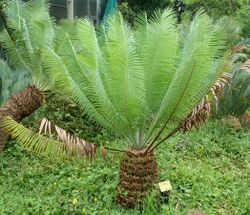Biology:Encephalartos inopinus
| Encephalartos inopinus | |
|---|---|

| |
| Scientific classification | |
| Kingdom: | Plantae |
| Clade: | Tracheophytes |
| Clade: | Gymnospermae |
| Division: | Cycadophyta |
| Class: | Cycadopsida |
| Order: | Cycadales |
| Family: | Zamiaceae |
| Genus: | Encephalartos |
| Species: | E. inopinus
|
| Binomial name | |
| Encephalartos inopinus R.A. Dyer
| |
Encephalartos inopinus is a species of cycad (Family Zamiaceae) that is native to Limpopo Province, South Africa .[3]
Description
This palm-like cycad grows up to 3 meters tall with stems that are 15-25 cm in diameter. Its leaves are 100-150 cm long, either blue or semi-glossy silver. The leaflets are 14-20 cm long, lanceolate, and have a toothed margin. They grow in pairs at a 180° angle along the rachis. The plant is dioecious, meaning it has separate male and female specimens. Male specimens have 1-3 green ovoid cones that are 18-25 cm long and 6-8 cm in diameter with green to silvery color.[4] Female specimens have 1-2 oval cones of the same color, which are larger at 30-35 cm long and 12 cm in diameter. Both types of cones appear in January, which is the middle of summer in the southern hemisphere. The seeds are 20-25 mm long, 15-20 mm wide, and covered with an orange sarcotesta. Both the macrosporophylls and microsporophylls have a flat, smooth, and glabrous surface.[5][6]
Etymology
Encephalartos is Greek and means 'bear's head'. Inopinus is Latin and means 'unexpected'.
References
- ↑ Donaldson, J.S. (2010). "Encephalartos inopinus". IUCN Red List of Threatened Species 2010: e.T41890A149624418. doi:10.2305/IUCN.UK.2010-3.RLTS.T41890A149624418.en. https://www.iucnredlist.org/species/41890/149624418. Retrieved 19 November 2021.
- ↑ "Appendices | CITES". https://cites.org/eng/app/appendices.php.
- ↑ "Encephalartos inopinus in Tropicos". http://www.tropicos.org/Name/50305206.
- ↑ Bothalia, Volume 8 (1964) p. 169
- ↑ Whitelock, Loran M. (2002). The Cycads. Portland: Timber Press (OR). ISBN 0-88192-522-5.
- ↑ "Encephalartos inopinus". https://pza.sanbi.org/encephalartos-inopinus.
External links
Wikidata ☰ Q3724975 entry
 |




